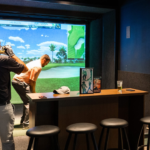
Players Indoor Golf & Sports Bar in Kitchener and Brantford Prepares for a Thrilling Season Reopening on September 22nd with League Registration Starting September 25th
September 25, 2023
Player’s Indoor Golf Winter Leagues Start in Kitchener and Brantford January 1st!
December 20, 2023Do you love playing golf but don’t have a golf course near your place or do the membership fees seem too steep for you? Indoor golf simulators are perfect for simulating a real golf course right in your living room or local sports bar without having to play outside. Golf simulators have come a long way since their introduction in the ‘70s thanks to cutting-edge technology and the integration of virtual reality.
Today’s golf simulators are complex computerized setups that are easy to install and allow you to enjoy a life-like golfing experience with family and friends. But how do these amazing pieces of VR sports technology work?
Here’s a brief rundown of everything you need to know about the inner workings of golf simulators and the technology behind them.
Key Takeaways
- Indoor golf simulators are an affordable solution to golf membership fees
- They’re made with cutting-edge technology to provide a smooth VR golfing experience
- There are different types of golf simulators based on the technology used.
Components of Golf Simulators
Modern-day golf simulators are a far cry from the primitive ones used even a couple of decades back. These days a gold simulator is a complex setup involving both hardware and software. On the hardware side of things, you’ve got cameras, radars, optical sensors, hitting mats, projectors and screens, enclosures, nets, and sound systems. The screen size can vary as most golf simulators these days can even support tablet and smartphone screens as well. But for the best experience, a large wide-screen TV is recommended
How Do Golf Simulators Work?
While golf simulators might look like complex pieces of hardware at first glance, their operating procedure isn’t any different than a computer. When you make a swing with your golf club, the software in the machine analyzes the force of the swing as well as the trajectory. Once the data has been compiled, the software analyzes the data in a fraction of a setting to provide real-time feedback and effect on the screen.
While swings are easier to measure, putting is a bit difficult for most golf simulator software to nail down. While some swing pads provide the required sensors to calculate putting, others do not. So make sure to check in the putting options in your hardware, and if there aren’t you might need to consider buying some additional peripherals to make it work. Otherwise, book your tee time at Player’s Indoor Golf to get putting right away!
The time to calculate is so fast for modern golf simulators that there’s literally no difference between playing in a real golf course and your living room. The screen imitates a full golf course while you stand back on the swing pad which is attached with motion sensors to capture your swing data.
To sum it up, golf simulators take each swing into account with the following steps:
- Taking the input from the swing pad
- Processing and analyzing the data acquired
- Provide the output based on the data collected and analyzed
Types of Golf Simulators
Based on the type of technology used, there are three types of golf simulators available in the market. These are:
Photometric
Ideal for both indoor and outdoor use, photometric golf simulators are camera-based systems that focus on capturing the high-speed image of simulated golf balls at the moment of impact. Based on the images taken, the data perimeters of the ball’s trajectory, launch angle, distance from the center, and force are determined which is then reflected on the screen. A significant upgrade over photometric systems which only take photos from one angle, stereoscopic, triscopic, and quadroscopic systems offer much better inferences since they take snaps of the ball’s trajectory from multiple angles.
Infrared
As the name suggests, infrared technology golf simulators emit infrared light signals to predict the trajectory of the ball after a shot. But the catch is you need special infrared indoor golf balls with sensors attached to them for this setup to work. But since the balls can be damaged easily or the sensors might malfunction, they’re not as dependable as photometric and radar-based indoor golf simulators.
Radar Technology
The most recent innovation in indoor golf simulators, radar technology emits a radio signal utilizing Doppler radar technology and then bounces it off the golf ball after impact. This golf simulator works best outdoors since it has to detect the travel course of the ball after impact to calculate the results properly.
Final Thoughts
Getting into indoor golfing is easier said than done considering the budget and preparations that have to be made. But once you’ve set everything up you’re in for a treat as your indoor golf simulator will keep you and your loved ones occupied for hours at an end. Just make sure to do your research and buy the right product and accessories that will last you in the long run.
Indoor Golf Clubs
If you’re looking for real-time analysis of your swing and how to better it, Indoor Golf Clubs has Full Swing Golf Simulators complete with TruGolf E6 simulator software. The E6 provides extensive swing analysis data including: club face, club path, back and side spin, launch angle and more! Combined with our 130″ projector screens, Indoor Golf Clubs give your the ultimate golf simulation experience!


